Recollections of the 1980 Voyage to Tahiti
Nainoa Thompson
On Learning Navigation
[After the 1976 voyage to Tahiti, navigator Mau did not sail back to Hawai'i with Hokule'a. There had been dissension on the canoe offshore of Tahiti, and because of this, he did not want to continue sailing and instead returned home to Satawal.1 Hokule'a was navigated back to Hawai'i with a compass and sextant. But back in Hawai'i, a group of Hawaiians, Nainoa among them, dreamed of voyaging to Tahiti again. Nainoa tried to teach himself traditional navigation by reading books, taking courses at the University of Hawai'i, and observing the night sky from land and at sea. But on one of the training sails on Hokule'a, he was puzzled by a moon rise and sought out a teacher who could answer his questions.]

The moon rose in a place I didn't expect. I expected the full moon to rise in the same place the sun had risen in the morning, but it came up somewhat to the south. Why? I thought I had understood the relationships between the path of the sun and the moon fully. This just didn't make sense.
When I got back home, I grabbed my astronomy books, but I couldn't find an answer in them-and I had no teacher. I thought someone at the planetarium at the Bishop Museum might have an answer to this riddle, so I called. The person who answered said, "Sorry, we don't have time to help you. Try Will Kyselka."
So at 6 a.m., I called Will and said, "I've got this problem with the moon!" He agreed to meet me. In the planetarium, he could move the stars anywhere, anytime in the world. He seemed to be able to answer all of my questions.
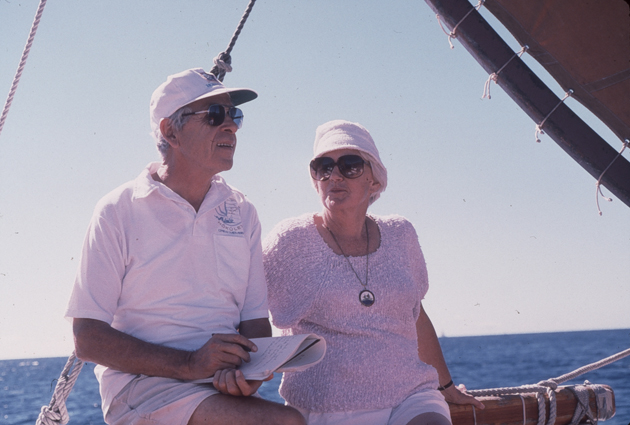
Will with his wife Lee on Hokule‘a. © Monte Costa
After that first all-day session, I still wanted to learn so much from Will, but I didn't think it proper to ask him. I thought that would be an imposition, that he was very busy. But Will must have sensed my wish because he finally said, "Why don't you come back again?" I had found someone who cared, who was willing to give up time to help another person learn.
We spent hundreds of hours together at the planetarium. I would figure out at home what I didn't know and then come to Will at the planetarium with my questions. And together we would look at the different skies to find answers. Will was teaching me the fundamentals of the skies and how they can be reduced to geometry, math, and science.
But Will was not just someone who fed me information. When I considered the dangers involved in sailing to Tahiti without modern instruments, I often thought it would be impossible. Will's calming, committed friendship helped me get through those difficult times. He wasn't just an astronomer teaching me about the stars. His lessons were about friendship.2
The 1978 Capsizing of Hokule'a
[A second voyage to Tahiti was planned for 1978. Hokule'a left Honolulu Harbor at 6:30 p.m. on March 16. A few hours later, after taking on water, the heavily-loaded canoe capsized in gale force winds and 8-10 foot swells in the Moloka'i Channel. The crew spent the night holding onto the leeward hull of the overturned canoe, hoping that a passing plane or ship would spot them. By mid-morning no one had come to the rescue. Fearing that the canoe would drift away from the islands and that crew members were physically tiring, the leadership gave Eddie 'Aikau, an experienced lifeguard and big wave surfer, permission to leave on a surfboard to get help. 'Aikau left at 10:40 a.m. At 9 that night, a Hawaiian Airlines pilot spotted flares from the Hokule'a; the Coast Guard was alerted and rescued the crew from the canoe; 'Aikau was never seen again.]
Eddie was totally intense and strong, but he was also a very caring man. He loved his culture. He loved the canoes. He was a total Hawaiian. He stood out. I will always remember a crew meeting, before the trip, at the Honolulu Medical Group down on Lauhala Street. Eddie brought a guitar and he was playing music. We were talking in the back, just the two of us, and he told me that what he wanted most in the world was to see Hawaiki [the legendary homeland] rise up out of the ocean.
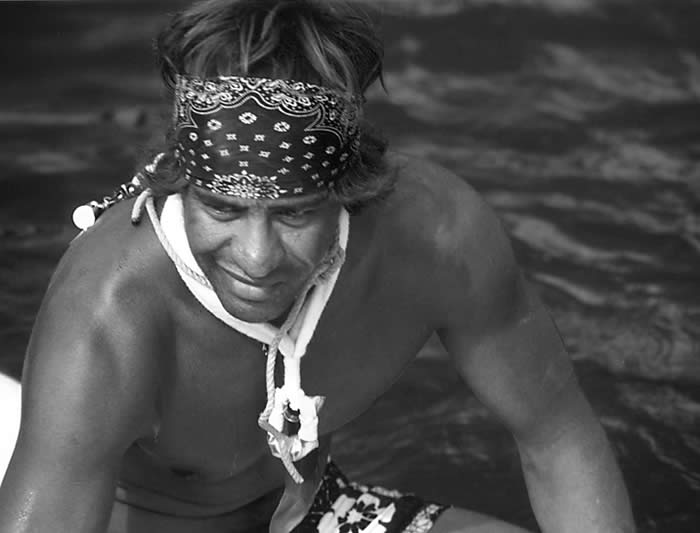
After Eddie's death, we could have quit. But Eddie had this dream about finding islands the way our ancestors did and if we quit, he wouldn't have his dream fulfilled. Whenever I feel down, I look at the photo of Eddie I have in my living room and I recall his dream. He was a lifeguard ... he guarded life, and he lost his own, trying to guard ours. Eddie cared about others and took care of others. He had great passions. He was my spirit.
He was saying to me, "Raise Hawaiki from the sea." But his tragedy also made us aware of how dangerous our adventure was, how unprepared we were in body, mind, and spirit.
Mau: Master Navigator, Master Teacher
We realized we did not know enough. We needed a teacher. Mau became essential. Mau is one of the few traditional master navigators of the Pacific left. And Mau was the only one who was willing and able to reach beyond his culture to ours.
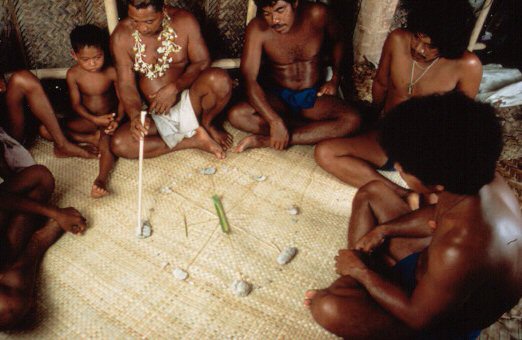
Mau teaching navigation on Satawal. Steve Thomas Collection, UH Manoa
I searched for Mau Piailug. Finally, I found him and flew to meet him. Mau is a man of few words, and all he said in answer to my plea for help was, "We will see. I will let you know." For several months I heard nothing. Then one day I got a phone call; Mau was going to be in Honolulu with his son the next day. When Mau arrived here back in 1979, he said, "I will train you to find Tahiti because I don't want you to die." He had heard somehow that Eddie had been lost at sea.
I asked him to teach me in the traditional ways. But Mau knew better. He said, "You take paper and pencil! You write down! I teach you little bit at a time. I tell you once, and you don't forget." He recognized that I could not learn the way he had learned.
Mau Piailug is from the island of Satawal. It's a mile and a half long and a mile wide. Population 600. Navigation's not about cultural revival, it's about survival. Not enough food can be produced on a small island like that. Their navigators have to go out to sea to catch fish so they can eat. Mau was not like me, who learned by using both science and tradition. I started at an old age, at about 21. He started at one. He was picked by his grandfather, the master navigator for his people, taken to the tide pools at different parts of the island to sit in the water and sense the subtle changes in the water's movements. To feel the wind. To connect himself to that ocean world at a young age. His grandfather took him out to sail with him at age four. Mau told me that he would get seasick and when he was seven years old, his grandfather would tie his hands and drag him behind the canoe to get rid of that. This was not abuse. This was to get him ready for the task of serving his community as a navigator.
Mau learned to turn the clues from the heavens and the ocean into knowledge by growing up at the side of his grandfather-he had been an apprentice in the traditional way. He had learned to remember many things through chants and would still chant to himself to "revisit information."
Mau's greatness as a teacher was to recognize that I had to learn differently. I was an adult; I needed to experiment, and Mau let me. He never impeded my experimenting and sometimes even joined in.
I never knew when a lesson started. Mau would suddenly sit down on the ground and teach me something about the stars. He'd draw a circle in the sand for the heavens; stones or shells would be the stars; coconut fronds were shaped into the form of a canoe; and single fronds represented the swells. He used string to trace the paths of the stars across the heaven or to connect important points.
The best was going out on my fishing boat with Mau ... every day! I watched what he watched, listened to what he listened to, felt what he felt. The hardest for me was to learn to read the ocean swells the way he can. Mau is able to tell so much from the swells-the direction we are traveling, the approach of an island. But this knowledge is hard to transmit. We don't sense things in exactly the same way as the next person does. To help me become sensitive to the movements of the ocean, Mau would steer different courses into the waves, and I would try to get the feel and remember the feel.
Mau can unlock the signs of the ocean world and can feel his way through the ocean. Mau is so powerful. The first time Mau was in Hawai'i, I was in awe of him-I would just watch him and didn't dare to ask him questions. One night, when we were in Snug Harbor, someone asked him where the Southern Cross was. Mau, without turning around or moving his head, pointed in the direction of a brightly lit street lamp. I was curious and checked it. I ran around the street light and there, just where Mau had pointed, was the Southern Cross. It's like magic; Mau knows where something is without seeing it.
I spent two Hawaiian winters with Mau. In the summer, ninety-five percent of the wind is trades, so it's easy to predict the weather. Tomorrow is going to be like today. But in wintertime you have many wind shifts. When I had spent enough time with him, I realized that he was not looking at a still picture of the sky. If you took a snapshot of the clouds and asked him, "Mau, tell me what the weather is going to be," he could not give you an answer. But if you gave him a sequence of pictures on different days, he would tell you.
He said, "If you want to find the first sign of a weather change, look high." He pointed to the high-level cirrus clouds. "If you see the clouds moving in the same direction as the surface winds, then nothing will change. But if you see the clouds moving in a different direction, then the surface winds might change to the direction the clouds are moving. That's only the first indication, but you don't really know yet. If clouds form lower down and are going in the same direction as the clouds up high, there is more of a chance that the winds will change in that direction. When the clouds get even lower then you know the wind direction will change."
Satellite technology was in its infancy then, and many times Mau's predictions would be right and the National Weather Service would be wrong.
He used the same clouds that we use to predict the weather--mare's tails, mackerel clouds. But in his world, he practices a kind of science that is a blend of observation and instinct. Mau observes the natural world all day. That's how he relates to nature. There are no distractions, so his instincts are strong.
In November of 1979, Mau and I went to observe the sky at Lana'i Lookout. We would leave for Tahiti soon. I was concerned-more like a little bit afraid. It was an awesome challenge.
Then he asked, "Can you point to the direction of Tahiti?" I pointed. Then he asked, "Can you see the island?"
I was puzzled by the question. Of course I could not actually see the island; it was over 2,200 miles away. But the question was a serious one. I had to consider it carefully. Finally, I said, "I cannot see the island but I can see an image of the island in my mind."
Mau said, "Good. Don't ever lose that image or you will be lost." Then he turned to me and said, "Let's get in the car, let's go home."
That was the last lesson. Mau was telling me that I had to trust myself and that if I had a vision of where I wanted to go and held onto it, I would get there.
Solving a Navigation Problem
In 1980, not only would I have to get down to Tahiti but also return home. To find Hawai'i without instruments, we sail to the east of it by dead reckoning. When we determine we are at the latitude of the islands, we turn west to look for them. But how do you know when you are at the right latitude? How do you know when to turn?
Mau didn't have the answer. How could he? In Micronesia, he uses the height of the North Star to determine latitude. The North Star over Satawal is only 7 degrees above the horizon. It's easy to measure that with the naked eye. But it's 22 degrees over Hawai'i - and that's not easy to measure without instruments. I needed to find some other way to determine the latitude of Hawai'i.
When a voyager sees the star Hokule'a [Arcturus] passing through the zenith-the point directly overhead-he knows he is at the latitude of Hawai'i. Not a problem on land. But how can you tell where the zenith is while standing on a rocking canoe? The point above your head keeps moving. We [Nainoa, Will, and Bruce Blankenfeld] spent a lot of time in the planetarium distracted by figuring out how to use zenith stars to determine latitude. But the closer I got to the voyage, the more I recognized that zenith stars were not going to work.
There were other patterns going across the planetarium sky over and over again, and the answers were all there, right in front of us all the time, but we didn't see them. And, as we got closer to the trip, the anxiety made it even more difficult to see them.
At the time, I was still living in an old one-bedroom house in Kuliouou. I had been studying this latitude problem and not finding any answers. One night I was asleep, and suddenly I sat up in my bed and said to myself, "That's it." In a dream, I saw the Southern Cross moving above the southern horizon-top star to bottom star, bottom star to the horizon, it was absolutely clear. It was so clear that I jumped up, ran down the hallway, jumped over my friend who was sleeping over, ran out the door, and sprinted down the road-because I knew that not only was the solution clear in my mind but this was the right time of the night to see it in the sky.
I ran past all the streetlights to Kuliouou Park where it was dark. There it was. The Southern Cross upright on the horizon-the top star to the bottom star, and the bottom star to the horizon, at the latitude of Hawai'i, are equidistant, 6 degrees apart.
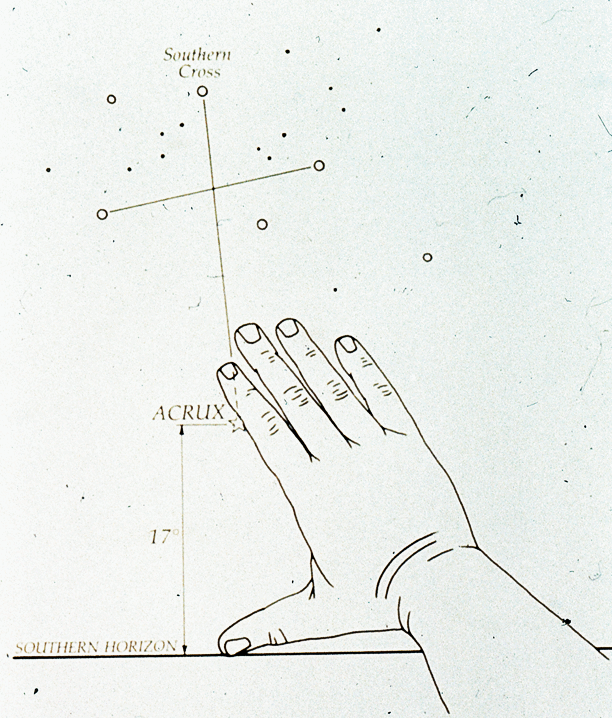
I called Will early in the morning. We met at the planetarium, and there it was-we confirmed my observation from the night before. The answer was always there-the Southern Cross was constantly going by on the planetarium dome, but we were always looking at the zenith star instead. The solution just emerged in my dream and now the solution is taught to everyone who studies navigation with us.
Navigating to Tahiti-1980
[In the spring of 1980, Hokule'a made a second voyage to Tahiti and back. Nainoa navigated the canoe both ways.]
The difference between the second voyage and the first one was that on the second voyage, the canoe was guided by, captained by, and crewed by people from Hawai'i. For our culture to really be alive, we recognized that we had to practice it ourselves.
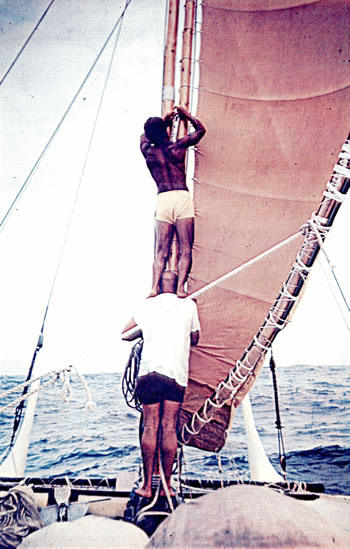
Sailing for Tahiti. Photo by Steve Somsen, documentor
Before we left I was panicking. I had the safety of the entire crew in my hands. There was intense media pressure. I had to appear confident, but inside I was very much afraid. The part of the trip I dreaded the most was the doldrums. I had no confidence that I could get through it. I thought that I could only accurately navigate if I had visual celestial clues and that when I got into the doldrums there would be a hundred percent cloud cover, and I would be blind. And that's what happened.
When we arrived in the doldrums, the sky was black. It was solid rain.
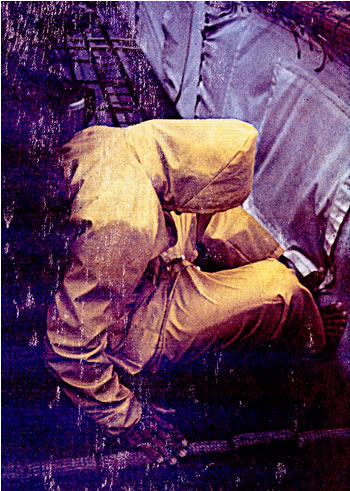
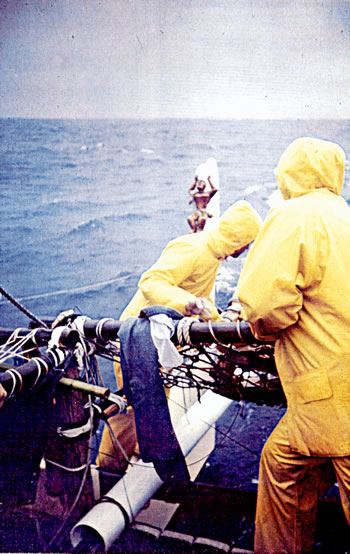
In the doldrums. Photo by Steve Somsen
The wind was switching around. It was about twenty-five knots, and we were moving fast. That's the worst thing that can happen-you are going fast and you don't know where you're going. The guys steering the canoe were looking for direction and that increased the pressure, especially because it was my first voyage. I couldn't tell the steersmen where to steer. I was very, very tense. To prevent fatigue, you cannot allow yourself to get physically tense, but I couldn't stop feeling tense.
I was so exhausted that I backed up against the rail to rest. Then something happened that allowed me to understand where the moon was, without seeing it. When I gave up fighting to find the moon with my eyes, I settled down. I suddenly felt this warmth come over me and I knew where the moon was. The sky was so black, I couldn't see the moon, but I could feel where it was.
From the feeling of warmth and the image of the moon came a strong sense of confidence. I knew where to go. I directed the canoe on a new course and then, just for a moment, there was a hole in the clouds and the light of the moon shone through-just where I expected it to be. I can't explain it, but that was one of the most precious moments in all my sailing experience. I realized there was some deep connection I was making, something very deep inside my abilities and my senses that goes beyond the analytical, beyond seeing with my eyes. I cannot explain what this is from a scientific point of view. But it happened. And now I seek out these experiences. I don't always have them. I have to be in the right frame of mind and beyond that, internally, I have to be able to enter into a kind of spiritual realm. I don't want to analyze these experiences too much. I just want to make them happen more often. I don't think there's an explanation for them. There are certain levels of navigation that are realms of the spirit.
Before that happened, I tended to rely on math and science because it was so much easier to explain things that way. I didn't know how to trust my instincts. They were not trained enough to be trusted. Hawaiians call it na'au – your instincts, your feelings, rather than your mind, your intellect.
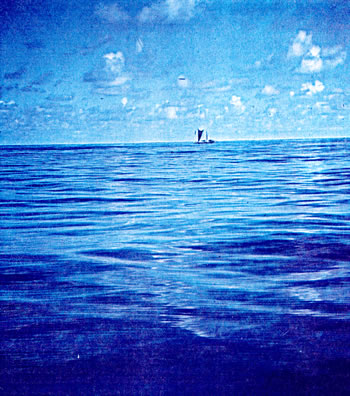
The doldrums on a clear, calm day. Photo by Steve Somsen
Course Strategy
Tahiti is smaller than Maui and it is a hard target to hit from 2500 miles away. Even hitting a target as large as the Big Island from that distance is outside of the accuracy of our navigation. When we go down to Tahiti, we have a mental image of our course line plotted for the trip. We try to stay on this course and end up in what I call a box. (See the map of the 1980 voyage to Tahiti.)

Black and White Map of 1980 Voyage
This box is large enough to compensate for any errors in our navigation. In this box there are many islands. All we have to do is to find one of them, and from that island we can find the others. For example, the target when we sail to Tahiti is a box four hundred miles wide, from Manihi in the Tuamotu islands to Maupiti in the leeward Tahitian islands. The first part of the journey to Tahiti is not trying to get to Tahiti but to make sure that we sail into this box and find an island. On different voyages, we have found Matahiva, Tikehau, and Rangiroa-all islands in the box. Since these are coral atolls it is very difficult to tell one from the other, so sometimes we have to land and ask the people what island it is that we've found. From any of these islands, we know Tahiti is only about 170-180 miles away and our navigation system is accurate enough to find it from that distance.
[See "On Wayfinding” and "Modern Wayfinding" for Nainoa's star compass and the techniques he used to design a course strategy and a reference course, hold direction, determine latitude, and tell what the canoe's position was east or west of his reference course.]
Finding atolls, which are very low, is extremely difficult, but there are a lot of clues to the presence of islands. The wave patterns change when an island is near. The behavior of animals in the sea, such as dolphins, will change. Mau can read these clues. The main guide is sea birds. There are two general types of seabirds that Mau taught us about. There are the pelagic seabirds-after the young are hatched and learn to fly, they go to sea and stay there, normally sleeping on the water or in the air and fishing until they become adults; then they come back to land to nest. The 'iwa bird is pelagic and we see it all the way across the ocean. Following these birds will not help you find land. The other type of birds are those that sleep on islands at night and at dawn go out to sea to fish. These land-based birds include the manu o ku (white tern) and noio (brown tern). Noio go about 40 miles out; the manu o ku go about 120 miles out. The Tuamotus are filled with these birds.
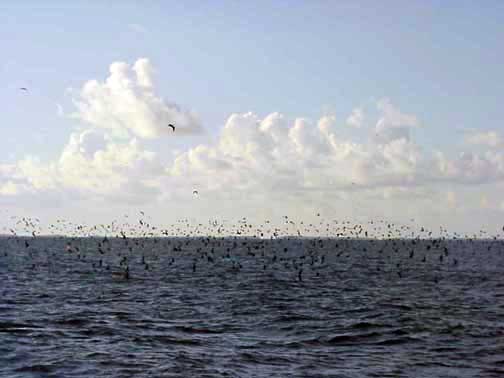
Birds off of Rangiroa in the Tuamotus. Photo by Na‘alehu Anthony
After we sail about 29 days down from Hawai'i and staring seeing these birds, we know the islands are close even though we can't see them. When the manu o ku is fishing, it flutters above the ocean surface, but when the sun starts to go down, it will rise up from the water so it can see farther, and it will head straight back to land. When we see these birds in the day we keep track of them and wait for the sun to get low and watch the bird; the flight path of the bird is the bearing of the island. Then we turn on that bearing, sail as fast as we can, and at sunset we climb the mast to see if we can find the island.
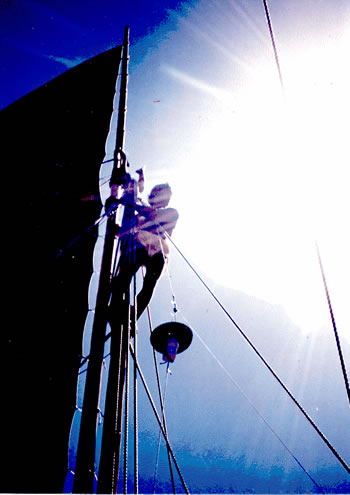
Photo by Steve Somsen
And if we can't see it, we heave to until the morning. On the voyage in 1980, we saw two birds after the 29th day and I was extremely relieved. At least we were in the ball park. I did everything that I was taught to do and the birds did everything that they were supposed to do. They went up high and they flew away and we sailed in that direction. We couldn't see the island at sunset, so we took the sails down at night and we waited. The next morning we looked for the birds to see what direction they were coming from. In the morning they go back out to the fishing ground, so the direction they are coming from is the direction to the island. We had a great crew of 14 and we made a ring around the canoe before dawn. We waited for the first bird. All hands on deck. Not a single bird. I was in near trauma-my first voyage, in my early twenties. Mau was very calm and didn't say anything. We waited and waited. The canoe was just sitting dead in the water, facing south. One of the canoe members was in the back of the canoe and a bird flew right over his head. The night before we saw the birds flying south so how could it be that late in the morning with the sun very high, this bird was also flying south? That would suggest that we passed the island during the night and now the island was back to the north. In my panic, I told the crew we should turn the canoe around and go north-to look for the island the bird was coming from. They turned the canoe around-and now we are sailing north, back toward Hawai'i. Now Mau has always said that his greatest honor would not be as a navigator but as a teacher-that he would come with us to make sure that the voyage to Tahiti would be safe, but if he didn't have to tell me anything, the honor as a teacher would be his. But after I started to sail north he came to me and said, "No." It was the first time that he interrupted the trip. He said, "Turn the canoe around and follow the bird." I was really puzzled. I didn't know why. He didn't tell me why, but we turned the canoe around and now we saw other birds flying south. Mau said, "You wait one hour and you will find an island."
After about an hour, Mau, who is about twenty years older than me-my eyes are physically much more powerful than his-got up on the rail of the canoe and said, "The island is right there." We all started looking, and we couldn't see it. Vision is not so much about just looking, but knowing what to look for. It's experience. Mau had seen in the beak of the bird a little fish, and he knew that the birds were nesting, so they had flown out earlier that morning and were taking food back to their young before they fed themselves. He just did not tell me that in our training program.
Not everybody can navigate. We have some great navigators in Hawai'i-Shorty Bertelmann from the Big Island; my brother-in-law, Bruce Blankenfeld from O'ahu; and Chad Baybayan from Maui. We base our projected course line before the voyage on average winds and sea conditions for 24 hours, but these are never average. The majority of navigation is observation and adjusting to the natural environment. The rougher the weather, the more the navigator needs to be awake and the less he can leave the crew on their own. We estimate that our navigators stay up between 21 and 22 hours a day, sleeping in a series of catnaps.
Mau says the mind doesn't need much rest. But the physical body does. When the navigator is on the canoe, the crew does the physical work. When he is tired, he closes your eyes. Mau told me that for him maybe his eyes are closed but inside here, inside his heart, he is always awake.
The navigator sleeps whenever his mind needs to rest. You work until you can't think, basically, then you lie down. I close my eyes and go to sleep. I have no dreams in the beginning. My first dreams are fire. I see reds and oranges. Then I get up when my mind is awake again. I do a series of those catnaps. The main thing is to make sure that your physical body doesn't do any work because then you get sick.
Initially, I depended on geometry and analytic mathematics to help me in my quest to navigate the ancient way. However as my ocean time and my time with Mau have grown, I have internalized this knowledge. I rely less on mathematics and come closer and closer to navigating the way the ancients did.
Crew Members, Hawai‘i-Tahiti:: Nainoa Thompson-Navigator. Pat Aiu, Chad Baybayan, Shorty Bertelmann, Harry Ho, Sam Ka`ai, Buddy McGuire, Marion Lyman-Mersereau, Mau Piailug, Gordon Pi`ianai`a, Steve Somsen, Jo-Anne Sterling. Leon Sterling, Tava Taupu
Notes
1. For Ben Finney's account of the blows on the canoe, see Hokule'a: The Way to Tahiti, pp. 240-248. Some thought the crew was too inexperienced to deal with the hardships and discomforts of a long voyage on an open canoe. Crew member Billy Richards explains the incident this way: "The conflict stemmed from two very different views of the voyage: for some, the voyage was a scientific experiment to learn the techniques by which Polynesians had explored and settled the Pacific; but for some of the Hawaiian crew members, the voyage was a highly emotional journey toward cultural reawakening. The crew's frustrations in preparing for Hokule'a's first long voyage, and the hardships and inequities during that voyage aggravated the differences."
2. See Will Kyselka's An Ocean in Mind, 3-104, for full account of Nainoa's training and preparation for his first voyage to Tahiti.
